Discover 11 hidden attractions, cool sights, and unusual things to do in Maysville (United States). Don't miss out on these must-see attractions: Simon Kenton Memorial Bridge, Russell Theatre, and William H. Harsha Bridge. Also, be sure to include Washington Opera House in your itinerary.
Below, you can find the list of the most amazing places you should visit in Maysville (Kentucky).
Table of Contents
Simon Kenton Memorial Bridge
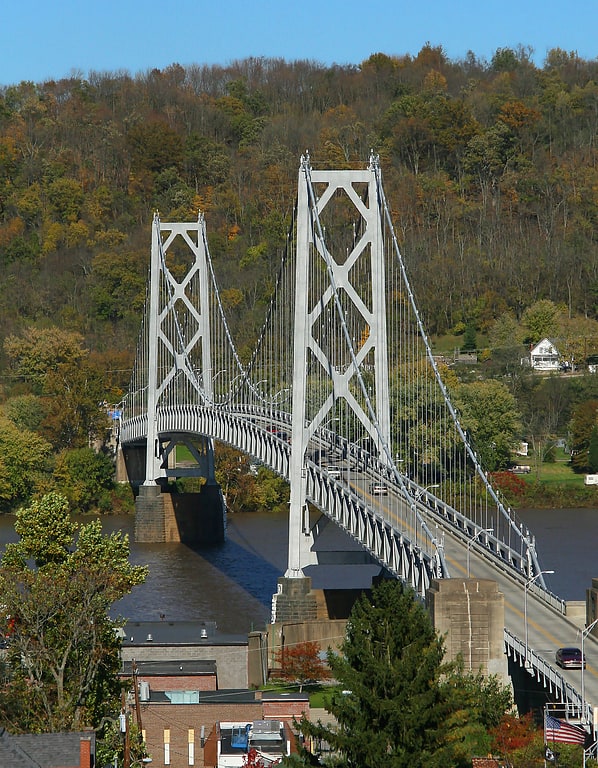
Suspension bridge in Maysville, Kentucky. The Simon Kenton Memorial Bridge is a suspension bridge built in 1931 that carries U.S. Route 62 across the Ohio River to connect Maysville, Kentucky with Aberdeen, Ohio. Its main span is 1,060 feet long, and the total length of the bridge is 1,991 feet. The bridge was designed by Modjeski and Masters and was open to traffic on November 25, 1931. Tolls were collected from the opening of the bridge until 1945.
The bridge was closed for rehabilitation in 2003 and 2004 after the William H. Harsha Bridge was completed. URS Corp. prepared the rehabilitation plans which consisted of a deck replacement, structural steel repairs, a new inspection walkway, and a new handrail on the main spans. The bridge was painted and returned to its original color, silver. It was rumored that the bridge was painted green during World War II to help 'disguise' it from air attacks. National Engineering and Contracting Company completed the construction and painting for the rehabilitation at a cost of $5.7 million.
In July 2019, The Kentucky Transportation Cabinet ordered a 3-ton weight limit placed on the bridge after a routine inspection found significant safety hazards with the cable suspension system. In November 2019, the bridge was closed due to corrosion in the suspension cable connectors. The bridge is expected to be repaired and put back in service by April 15, 2020. As of May 21, 2020, the bridge remained closed after an inspection of the cable repairs determined that the bridge needed rust-proofing.
On June 12, 2020, the bridged reopened for traffic with a 15-ton weight restriction after being closed for nearly 6-months so a short-term fix could be done to reduce stress on 19 damaged cables and rust coated. The bridge is expected to undergo major rehabilitation work in the future, including replacing all cables.[1]
Russell Theatre

Movie theater in Maysville, Kentucky. The Russell Theatre is a building in Maysville, Kentucky that was originally intended as a movie theater but has since been adapted for other uses. Construction of the Russell Theatre was announced by Maysville businessman Col. J. Russell Barbour in 1928. The structure costing $125,000 opened on December 4, 1930 with a showing of the movie "Whoopee," starring Eddie Cantor. The building site was previously occupied by wholesale grocery warehouses.
The structure is a freestanding, three-story building with a 80 feet (24 m) by 165 feet (50 m) rectangular footprint with an area of about 13,000 square feet (1,200 m2). The exterior features a Spanish-Moorish Revival style with a tower on either end of the principal facade. The box office is finished in Rookwood tile. Although constructed as a movie theater, the Russell did have dressing rooms for live performers and an orchestra pit. The auditorium was decorated as a Mediterranean garden complete with Lombardy poplar and literary busts set into wall niches. A rainbow would appear over the stage at the end of the movie.
Col. Russell operated the theater until 1935 at which time operations were turned over to the Schine group. In 1953, the Russell theater presented the world premiere of Maysville native Rosemary Clooney's movie "The Stars are Singing". In the early 1970s, the Panther Group took over operations and repainted much of the jewel toned decoration with bright primary colors. The Panther Group continued to operate the theatre until 1983. In subsequent years, the building was used as a restaurant, a used furniture store, a used clothing store, and a newspaper utility building before its eventual close.
After its abandonment, strong storm winds ripped off a roof section and the damage was not immediately repaired. The interior plaster work was extensively damaged by subsequent exposure to rain. In 1995, a committee was formed to restore the building. The roof was repaired and the exterior appearance has been restored, but interior restoration is not complete.[2]
Address: 9 E 3rd St, Maysville
William H. Harsha Bridge
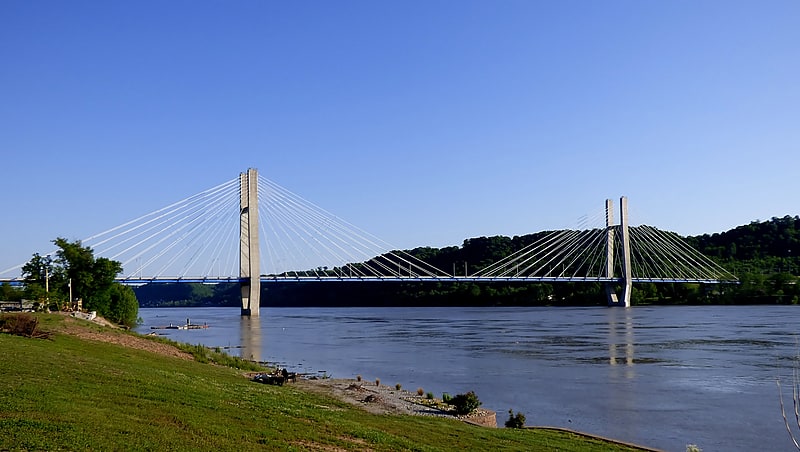
Bridge in the United States of America. The William H. Harsha bridge is a cable-stayed bridge carrying U.S. Route 62 and U.S. Route 68 that connects Maysville, Kentucky, and Aberdeen, Ohio, over the Ohio River. It is named for William Harsha, who represented the Ohio portion of the area in the United States House of Representatives. Construction on the bridge started in 1997 and it opened in 2000. The bridge has a main span of 1050 feet and a total span of 2,100 feet. The Simon Kenton Bridge, a suspension bridge built in 1932, is located nearby.[3]
Washington Opera House
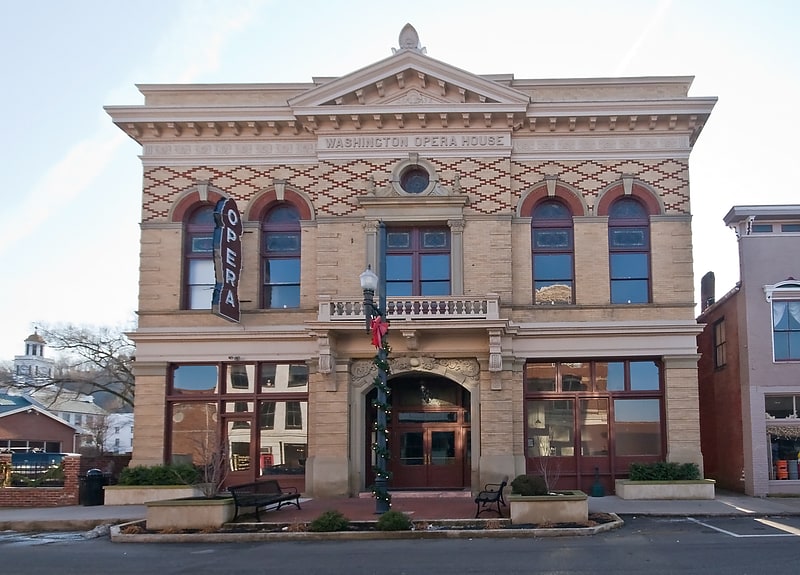
Opera house in Maysville, Kentucky. The Washington Opera House is a 2 1/2 story structure near the western end of the main downtown shopping district of Maysville, Kentucky. The sides and rear of the theater are of red brick while the facade is of buff brick trimmed with red brick, stone, and cast iron.
The tradition of theater in Mason County dates back to at least 1797 according to the Washington, Kentucky newspaper, The Mirror. The performance at the "Court House" is the first record of a stage performance west of the Alleghenies to disclose play titles, performance dates and prices. By 1817, there was a theater in Limestone (Maysville) at the corner of 2nd Street and Fish Street (now Wall Street).
A disastrous fire destroyed a significant amount of property on West Second Street in April 1850 including the Presbyterian Church, then known as the Old Blue Church. The church congregation decided to rebuild on Third Street, leaving the Second Street lot vacant. In 1851, two fire companies were formed to prevent a repeat of the town fire and an elegant theater, "The Opera House", was built on the site of the Old Blue Church.
In 1898, fire struck again and "The Opera House" was destroyed. Perhaps from remorse, the Washington Fire Company, organized at the time the theater was built - nearly five decades before, decided to rebuild it at a cost of $24,000 and the new structure was thereafter known as the "Washington Opera House".
A number of famous artists and actors performed here including Marguerite Clark, Tom Mix, John L. Sullivan, and John Philip Sousa and his band. The Washington Opera continues as a theater and is currently home to the Maysville Players.[4]
Address: 116 W 2nd St, 41056-1003 Maysville
Kentucky Gateway Museum Center
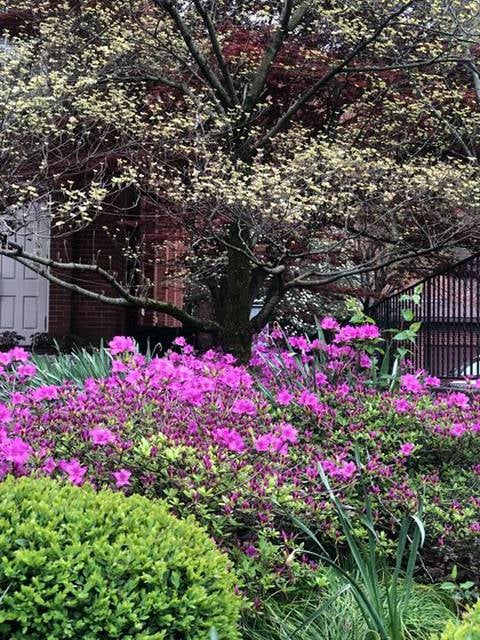
Specialty museum, Museum
Address: 215 Sutton St, 41056-1109 Maysville
Cox Building

Historical landmark in Maysville, Kentucky. The Cox Building is a historic building located in Maysville, Kentucky, United States. Brothers George L. and William Hopkinson Cox began construction of the Richardsonian Romanesque structure at Third and Market Streets in 1886 and completed construction the following year. The project also included the construction of seven contiguous brick homes extending south along the east side of Market Street to Fourth Street.
The building was designed to accommodate three large storefronts on the ground floor with associated second-story storerooms for each. The remainder of the second floor was originally designed as an upscale professional office space for up to nine tenants. In practice, the nine offices were often joined into larger office suites and were later converted into apartments. The upper three stories of the Cox Building were designed explicitly for use as a Masonic Temple, specifically for the York Rite "Knights Templar".
The City of Maysville purchased the building in 2006 for $200,000 as a restoration project. The roof, fourth and fifth floors were destroyed by fire on November 9, 2010. Restoration work continued and the completed work was dedicated at 11:00 am on September 7, 2012.[5]
Cox-Hord House
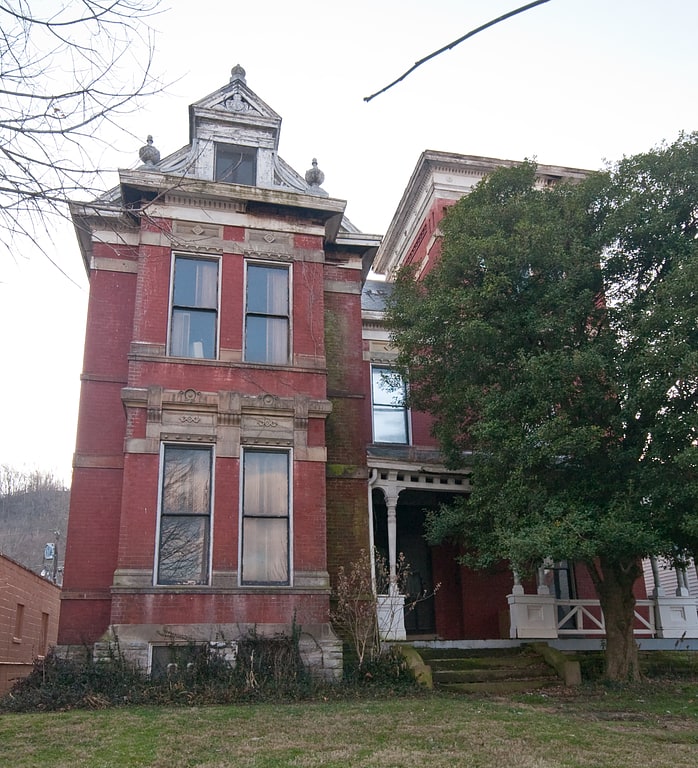
Historical landmark in Maysville, Kentucky. The Cox-Hord House is a three-story brick structure in Maysville, Kentucky designed by Cincinnati architect, Edwin Anderson, and built in 1880 at a cost of $49,000. The architectural style is eclectic with elements of Victorian Gothic, Italianate and Victorian Romanesque. It is considered an excellent example of the "Mauve Decade" due to the "use of the finest materials and superb workmanship". Ceiling heights are 14' for the first floor, 12' for the second and 10' on the third. A variety of wood was used for interior trim including light and dark walnut, cherry, fruit wood and ebony.
The house was built in 1880 for Andrew Cox and his wife, Mary Thomas Cox, daughter of a local distiller. In 1897, it was sold to wholesaler Milton Russell, and sold again in 1926 to Ferdinand Hechinger for his daughter, Rebekah H. Hord,
Rebekah Hord was active in Maysville civic affairs and is noted as the first elected female mayor in Kentucky, serving from 1951 to 1962. Hord's daughter and grandson were also elected Mayor of Maysville in 1986 and 1999 respectively.[6]
Phillips' Folly
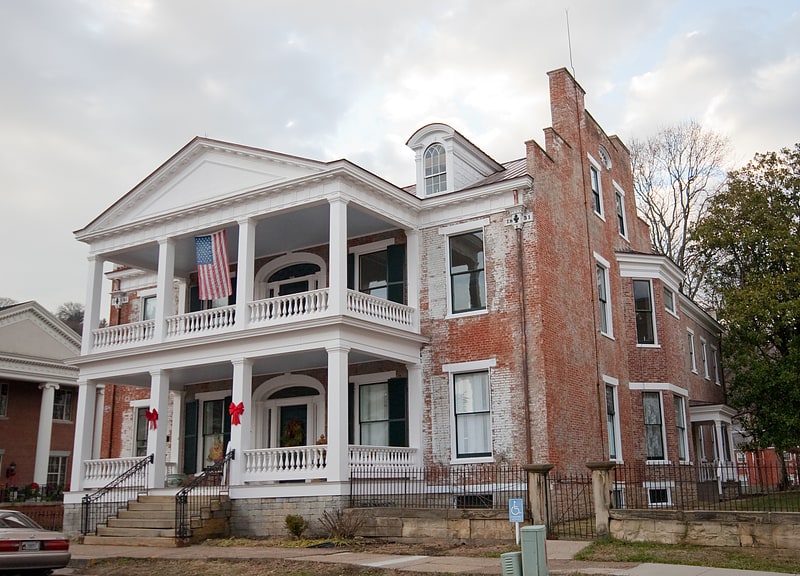
Home. Phillips' Folly is an historic three-story brick residence in Maysville, Kentucky. The home's Antebellum architecture displays a blend of styles which may be explained, in part, by the home's speculative six-year construction period, which ended with its completion in 1831. The Sutton Street entrances are Federal, windows are typical Greek Revival in their size and character, and the two-tiered portico and the segmental dormers reflect a Georgian influence. The portico and Doric frieze are similar to Drayton Hall near Charleston, South Carolina. The stepped parapets on the end walls are peculiar to the Ohio River Valley and are "associated with the 'Dutch' character of Cincinnati, Ohio and the surrounding area." The home also possesses an artful and unique dry stacked foundation that is set without mortar.
William B. Phillips was Maysville's second mayor and was among those who welcomed General Lafayette during his 1825 Maysville visit. Phillips is listed as serving as Mason County's state legislator in1820. Phillips' residence earned the term "folly" because the mansion's construction began as early as 1825, but was halted for up to six years due to lack of funding. According to a 1973 magazine article, "leaving the house unfinished, the owner disappeared for two years, during which time he won enough money at gambling to complete the structure".
Phillips sold his "folly" to wealthy businessman John Armstrong in 1838. Armstrong was instrumental in the early development of the Commonwealth of Kentucky and Maysville, Kentucky, in particular. Armstrong was the first to sign a petition to move the county seat from Washington to Maysville. Armstrong was a member of the company responsible for building the Maysville and Lexington Turnpike, which was the subject of the significant historical decision involving U.S. President Andrew Jackson, Secretary of State Martin Van Buren and Congressman Henry Clay referred to as the Maysville Road veto. The Maysville Road veto served as one of President Jackson's first acts in aligning the federal government with the principles of what would later be known as Jacksonian democracy. Armstrong established the first bank in Kentucky in 1818. Armstrong died in the home in 1851. After John Armstrong's death, the home was willed to Armstrong's son, Francis Woodland Armstrong, who served as an noted abolitionist.
The Reed family owned the home from 1894 to 1904. Dr. John Reed maintained a medical practice in the basement of the residence for about 10 years. Also during this period, the residence was the adolescent home of U.S. Associate Supreme Court Justice, Stanley Forman Reed. Justice Reed spent formative years in the home until leaving for college. Reed would go on to serve in the Kentucky House of Representatives and as U.S. Solicitor General, where he defended the constitutionality of several New Deal policies. President Franklin D. Roosevelt nominated Reed to the Supreme Court in 1938. Justice Reed served the nation's highest court until his retirement in 1957. Justice Reed wrote the majority opinion for the cases Smith v. Allwright, Gorin v. United States, and Adamson v. California. He authored dissenting opinions for the cases Illinois ex rel. McCollum v. Board of Education. Reed was the final pivotal voice for the unanimity of the U.S. Supreme Court landmark decision in Brown v. Board of Education.
According to oral history, during the ownership of Francis Woodland Armstrong, the mansion served as an important post along the Underground Railroad. During this time corresponding with the American Civil War, runaway slaves were held in a wooden jail cell that dates to the home's original 1831 construction. Runaway slaves would be housed in the basement jail cell until it was deemed safe for them to continue their journey to the nearby free state of Ohio. It is believed that slaves were kept in the jail to foil slave hunters who were likely to search the home. A tunnel leading to a secret room once used by slaves to escape to the Ohio River can still be seen in the home's basement. The basement jail cell is still intact today and is thought to have also served as an early town jail during the ownership of Mayor Phillips.
In March 2011, Ghost Adventures from the Travel Channel filmed at Phillips' Folly. The episode aired on Friday, May 13, 2011. It featured former resident and Underground Railroad historian, Jerry Gore. Phillips' Folly has been called one of the most haunted homes in Kentucky. The home is said to be the residence of several spirits, including John Armstrong and his Newfoundland dog; by John Pearce who died in the home around 1890 either by fighting a duel in the home's back parlor or by suicide in the home's back parlor (dueling was outlawed at the time, therefore death by suicide may have been the manner of death officially recorded); and by former slaves who were chained in the basement prior to the home's abolitionist history. The home's backyard is directly adjacent to one of the oldest known cemeteries in Kentucky (circa 1800–1850) referred to locally as the Maysville Pioneer Graveyard, which was established on land acquired by city trustee Jacob Boone, close friend, business partner, and cousin to Daniel Boone. Jacob Boone and his family are buried in the Maysville Pioneer Graveyard in a plot notating Jacob's militia service during the American Revolutionary War.
Phillips' Folly was added to the National Register of Historic Places on August 10, 1978. Phillips' Folly is a private residence.[7]
Lee House
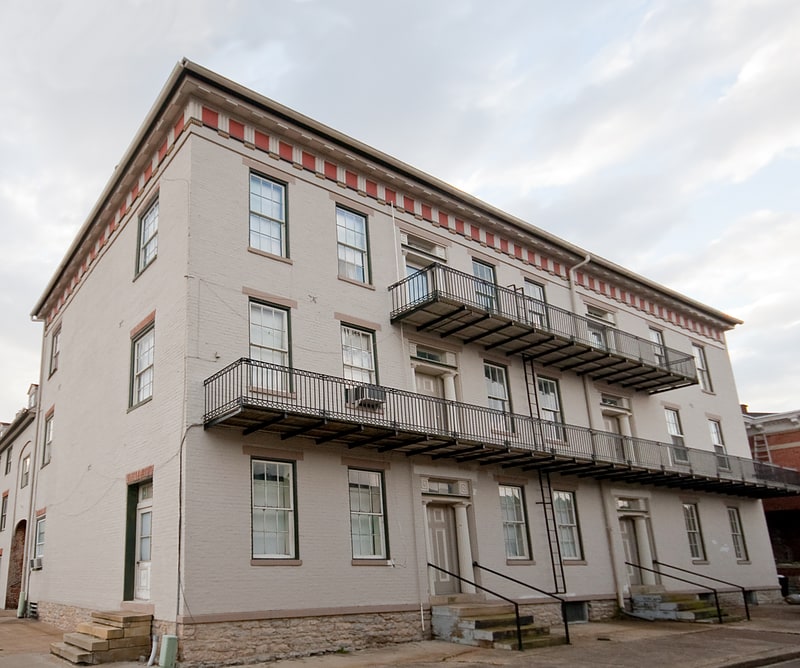
Building in Maysville, Kentucky. The Lee House facing front street was built as a hotel by Peter Lee in 1844. It was considered one of the finest inns of the day and hosted a number of prominent guests including Henry Clay and Governor John Chambers. The inn became a popular stop on the way for summer tourists destined for the Blue Licks Spring. A number of parties and masked balls were held in its generous rooms.
The complex consists of an original structure facing Sutton Street (circa 1790), the building facing Front Street (1844) and a three-story addition of 16 hotel rooms (circa 1850). Most of the design elements are Greek Revival and the brickwork is Flemish bond. Construction of the floodwall in the early 1950s protected the structure from flooding, but blocked the river view from the lower two stories.
The structure was bought in 1863 by Charles B. Hill and was known for some time as the Hill House. In 1977, it was listed on the National Register of Historic Places.[8]
John Brett Richeson House
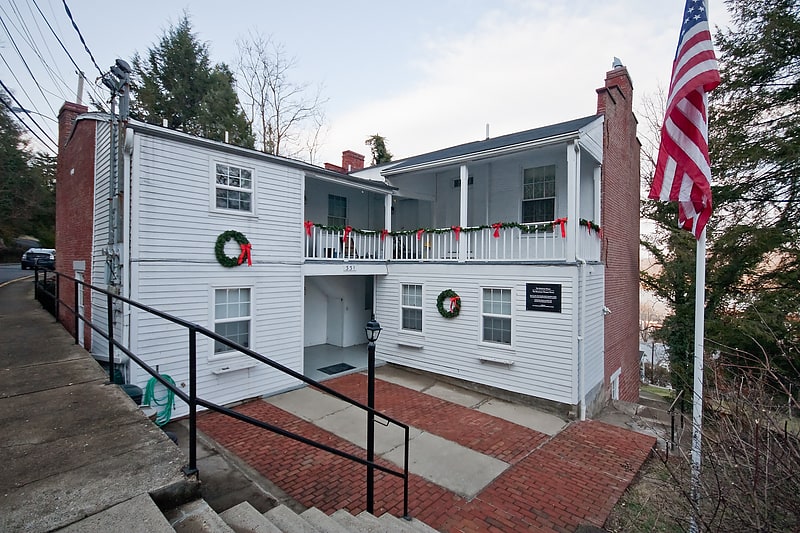
The John Brett Richeson House in Maysville, Kentucky was built in 1832 and purchased by John Richeson, an educator from Charlottesville, Virginia, for his wife Mildred Richeson and their eight children. The house was occupied by the Richeson family for more than 100 years until the death of Edward Richeson in 1941.
The Richeson family provided Maysville with some of the most accomplished and brilliant teachers ever known in Kentucky, and they helped to establish Maysville as a leading educational community during the period 1832–1880. Several of John Richeson's children were teachers, including sons William and John Richeson, and his daughter Ann Frances Richeson Peers. Several grandchildren were also teachers.[9]
Armstrong Row

Building. Armstrong Row is a series of 11 brick row houses in Maysville, Kentucky built between 1820 and 1833 by John Armstrong, a local industrialist, entrepreneur and real estate developer. Vacant lots were purchased by an Armstrong owned company that operated the Maysville cotton mill. The company continued to operate as the January & Wood Company until 2003. Armstrong also developed a number of other row house projects in Maysville including the Federal style row houses on Limestone Street, Mechanic's Row, and the "Allen Block".
The Armstrong Row houses are two story brick with gable roofs and stepped parapet walls in both Federal and Greek Revival style. The facade is Flemish bond and sides are common bond. Although similar in construction, the gable roofs vary in pitch suggesting the buildings were constructed either by more than one builder or over a period of time.
John Armstrong was born in Ireland in 1779 and emigrated to America with his family circa 1790. He bought his first Maysville property in 1800 from Jacob Boone, a first cousin of Daniel Boone. He later operated several wholesale houses on front street becoming wealthy in the process.
Armstrong was instrumental in the early development of the city and was the first to sign a petition to move the county seat from Washington to Maysville. He was a member of the company responsible for building the Maysville and Lexington Turnpike, he established the first bank in Kentucky in Maysville in 1818, and was a member of the committee that welcomed General Lafayette to Maysville in an 1825 visit.[10]